History of the light microscopy
Ancient world
of enlargement. Seneca (1-65 A.D.) for example reported once: Letters of a document seem to be larger an brighter, when holding a glass bowl of water over it. The problem was, they didn´t understood the principles behind it. So they were not able to turn this knowledge into a useful technology.
Alhazen (965–1039)
Alhazen was a Muslim savant with Persian / Arabic origins. He discovered the relevance of oval glass surfaces for light refraction and for enlargement. He produced reading stones from glass and therefore he is said to be the inventor of the magnifier. It was probably his work, which inspired Roger Bacon to develop spectacles like we know them today.
Alhazen had noted, that the human eye is built like the lenses, which people used to enlarge script. Therefore he was convinced, that that our eyes just convert the light, which is reflected from objects in our environment. With this finding, he refuted an ancient theory from Aristotle. Aristotle assumed, that our eyes send out beams to scan the surroundings, just like a radar.
Salvino D’Armati (1258-1317)
One can find this name on many internet sites in connection with the invention of spectacles. This man is a historical fake, which was finally clarified in the year 1920. Salvino D´Armati never existed and he surely never invented the spectacles.
Roger Bacon (1214-1292 or 1294)
Based on the written records of Alhazen, Bacon managed to drag oval glass lenses, which could be used as an optical aid for people. He developed spectacles, like we know them today:
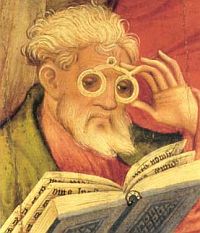
As a frame with two glasses, worn above the nose.
William Harvey (1578-1657)
Harvey is one of the most important precursors of modern medicine. He found out, how the human cardiovascular system works. Before he did, people thought that our blood is produced in the liver and is moved through the body by contractions of the veins.
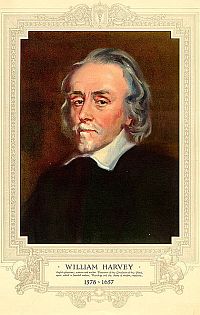
Harvey´s research methods were as revolutionary as his findings. His approach was to draw a hypothesis and then to verify it with evidence. He accepted only results, which could be proven by scientific checking tests.
Harvey´s theories left one important open question: how the blood is transported from the arteries to the veins? Marcello Malpighi gave the answer 3 years later, in 1661. By using a microscope, he found out that the capillaries fulfil this task.
Marcello Malpighi (1628-1694)
Malpighi was an Italian doctor and anatomist. He is considered as the founder of several sciences: the histology, the plant anatomy and the comparing physiology. Histology is the science of biological tissues and concerns with the examination of tissue samples on a microscopic level.
With the help of the microscopy, Malpighi could prove the unanswered questions in William Harvey´s theorie of the human cardiovascular system.

Malpighi´s efforts in his area of expertise were so important, that several structures were named after him: Malpighian corpuscles or Malpighian tubule.
Hans Lipperhey (1570-1619)
Lipperhey was an optician from Middelburg in the Netherlands. He is regarded as one of the inverntors of the “Dutch Telescope”.
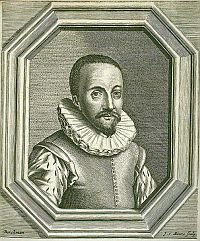
More about him and the invention in the next passage.
Zacharias Jansen (1588-1631)
Jansen is, just like Lipperhey, regarded as one of the inventors of the microscope / telescope. Today, one can´t say exactly, who of the two gentlemen was the real inventor. All that´s known for sure is, that both Jansen and Lipperhey tried to register for a patent in the year 1608. As they both lived in Middelburg, it is very likely that one had stolen ideas from the other.

Besides this discussion, it is pretty clear, that Jansen and Lipperhey experimented with optical instruments to achieve a higher magnification factor. They probably both came to the result, that a combination of two or more lenses can exponentiate the enlargement effect.
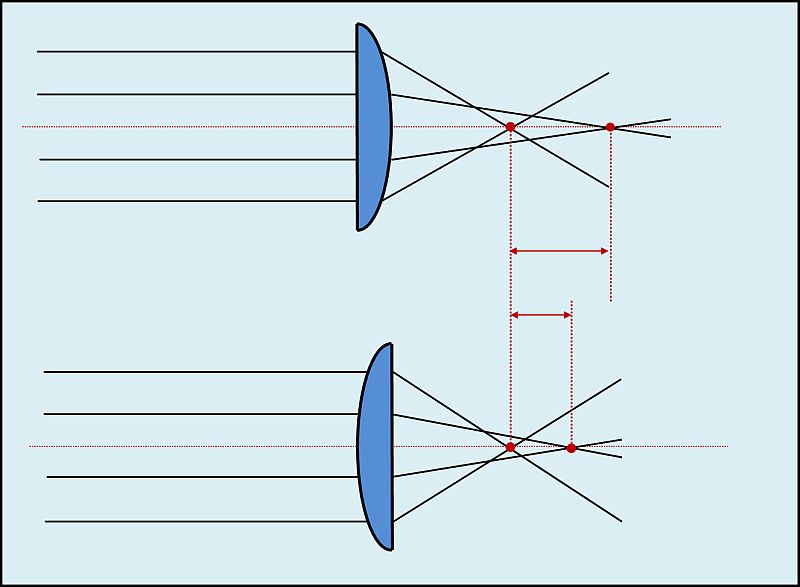
Jansen developed a gadget, which one can see very often in pirate movies. It is the tube, where the captain looks through to identify enemy ships in the far. This telescope consisted of two tubes. By compressing and uncompressing them, the user could adapt the focal distances of the lenses to the distance of the object.
Jansen used two lenses. The ocular was a biconvex lens, the objective was plano-convex. In this time, it was a rather progressive construction. Plano-convex lenses are used to improve the image sharpness, as they reduce the effect of the so called “spherical aberration”.
Spherical aberration: biconvex lenses normally collect all parallel light rays into one point, the focus. But this is just the ideal situation. In real, the rays don´t meet exactly in the same point after leaving the lens. There are several focal points, which leads to an unsharp image. The higher the enlargement factor, the more worse becomes the picture. The closer the focal points can be moved together, the better the quality. And this is what a plano-convex lens can do. One of the criterias, that can differentiate microscopes of good and worse quality, is how good they can reduce image defects like spherical aberration.
Johannes Kepler (1571-1630)
Kepler was a German mathematician, astronomer and optician. He invented a telescope, which was named after him – the Kepler telescope. Kepler was a friend of Galileo Galilei and supported his theories with his own observations. Kepler and Galilei immensely contributed with their work, to the acceptance of the heliocentric system of Copernicus.
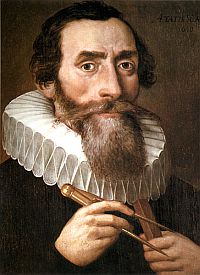
The heliocentric system bases on the assumption, that the sun is the center of the galaxy and the planets revolve around it. This theory conflicted with the church´s geocentric view of the world of. The church claimed, that the earth is the center of everything and all the planets revolve around it.
Kepler´s book “Dioptrice” was published in the year 1611. Therein he describes very important basic principles of optics and several findings about light refraction and magnification. For him, these findings were only a byproduct of his other research.
Galileo Galilei
In 1609 Galilei heard about the invention of the Dutch telescope. On the basis of the received descriptions, he copied the gadget with purchased lenses and achieved a magnification factor of 4. After that, he began to grind lenses by himself and constructed several telescopes, which even reached a factor of 33. His best telescope was 60 centimeters long and consisted of one convex and one concave lens.
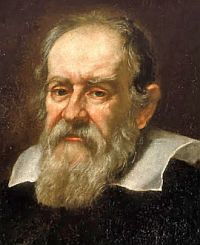
In the same year Galilei presented his device to the Venetian government, called “la Signora”. It´s value was obviously immeasurable, especially for military causes. One day after the presentation, he gave the exclusive rights on his tool as a gift to the “la Signora”. From the economic perspective, an absolutely wrong decision, as he could have become very rich with it.
Galilei was one of the first scientists, who used a telescope to examine the universe. With his gadget, he made several, revolutionary findings, which lead to a correction of the prevalent world view. The problem was, his discoveries conflicted with the church´s convictions. Instead of respect and honor, he only earned trouble and problems. He had to spend a part of his life in prison and house arrest.
Francesco Stelluti (1577-1652)
In the year 1630, Stelluti made a drawing of a bee.
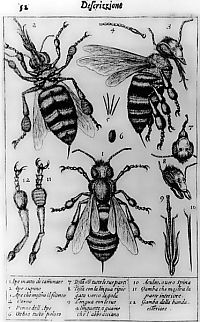
It is considered as the eldest drawing, which was made with the help of a microscope.
Athanasius Kircher (1602-1680)
Kircher was a German Jesuit and was one of the first scientists, who used a microscope to examine different diseases. He tested blood samples of pest infected people and discovered tiny organisms in it. He described them in his Book “Scrutinium Pestis” in 1658 and assumed them to be the cause of the disease. Today, historians are convinced that it was red and white blood corpuscles that he saw. Nevertheless, he was close to the truth.
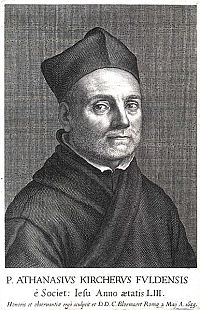
He drew the right conclusions and developed modern measures to stop the dispersion of the disease. He suggested the isolation of infected people from others, to burn their clothes and to wear face masks in case of contact.
Antoni van Leeuwenhoek (1632-1723)
Leeuwenhoek is considered as one of the most important persons in the history of the microscope. He mainly built microscopes with only one lens, so that we should actually say: high-performance-magnifiers. His lenses were dragged so precisely, that they were almost perfectly spherical. This allowed him to achieve a magnification factor of over 200. Microscopes with two or more lenses were already applied at this time. But the lenses had many errors and inclusions, so their performance couldn´t mess with that of Leeuwenhoek´s constructions.
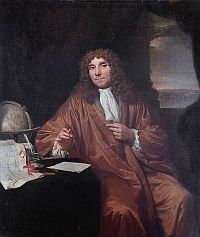
Unfortunately Leeuwenhook never told his manufacturing methods to anyone else and his secret died with him. It took several centuries, until one could build as good microscopes as he did. Historians speculate, that he had bought diamond dust from jewelers to drag his lenses so perfectly. Others assume, that he melted glass. When pulling apart a glowing glass stick, in the middle there remains a glass fathom. When holding this fathom into the fire again, it shrinks to a globe, which can work as an excellent lens.
With his microscopes, he explored the world of tiny objects and made lot of new discoveries. For example, he evidenced that grain weevils, fleas and bivalves reproduce by laying eggs, instead of growing simply from the dirt or sand. He made many drawings of his objects and sent them to the Royal Society in England. His research, lead to a completely new way of thinking about how the human body works and how diseases arise.
Robert Hooke (1635–1703)
Hooke was an English polymath. There is no existing picture of him available. As genial he was, his versatility became his doom. Instead of becoming an expert in one subject, he investigated a little bit in every topic. Additionally, he was said to be displeasing character with a carping tongue. This was probably the reason for the fact, that he never earned as much respect as he could have. His research included topics like: gravity, the consistence of light and the spectral colors, the invention of a spring driven clock, geology, astronomy – besides from that, he worked as field surveyor and architect…

Additionally, he constructed gadgets for magnification: telescopes and microscopes. With them, he explored the universe far away and the microcosm.
Hooke was a member of the Royal Society. He was asked to provide a book with drawings of the objects, which he had examined under the microscope. In 1665 he published his most famous book named “Mikrographia”. Therein, in one chapter, he describes the texture of cork. He found the same structure in plants and it reminded him of cells. Therefore, Hooke is the discoverer of plant cells and he was the one, who made the word “cell” common in the science of biology.
Filippo Bonnani (1638-1725)
Bonnani was an Italian Jesuit priest, who also worked as a microscope constructor and natural scientist. He was the first person, who described a self-made object plate in his book “Micrographia Curiosa” (1691). It was a construction of two mica sheets, which were fixed to a brass plate with two spring holders. This kind of construction was named after him: “Bonnani spring stage”.
Ernst Abbe (1840-1905) – Matthias Schleiden (1804-1881) & Carl Zeiss (1816-1888)
In the 19th century, the construction of microscopes had no scientific base. The manufacturers began working and “played” with several lenses until they achieved an acceptable result. The problem was: a good result could not always be reproduced again. It was also not yet possible to preestimate the magnification factor.
The German scientist Matthias Schleiden was a prominent expert in the newly-created science of cell biology, the cytology.

He convinced the young entrepreneur Carl Zeiss of the necessity to improve the technology of microscopes. This would help all other cytologists to do a better research.

Zeiss, in turn, contracted the young Ernst Abbe in 1866 to examine the principles of optics and magnification. His mission was to give the construction of microscopes a scientific base.
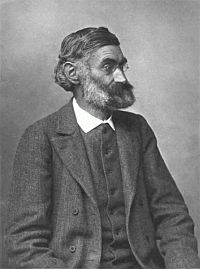
Abbe examined several types of microscope objectives and the rules of optics in general. He found out, that besides from light refraction the diffraction is also playing an important role. To describe the diffraction, he formulated the “Abbe sine condition”.
His research, lead to an immense improvement in the performance of light microscopy and made a serial production possible.